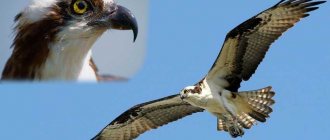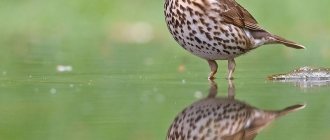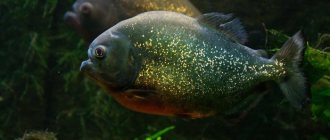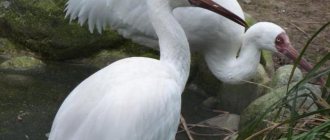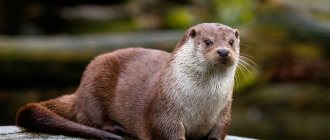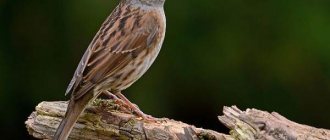Appearance
— Advertising —
Appearance of a cuckoo
The cuckoo has a long, thin body, narrow wings pointed at the end, and a long tail, beveled along the edge in the shape of a wedge. The legs are short, poorly developed, and unsuitable for walking on the ground. The structure of the paws is zygodactyl - two claws look forward, and the other two are turned back. The beak is short, curved downwards.
Sexual dimorphism is expressed in size (males are larger than females) and plumage. Adult males have a gray head, shoulders, and back. The throat and upper chest are ashen. The belly and chest are cream with wide black transverse stripes. The tail feathers are dark gray with white spots and edges.
Photo of a cuckoo on a tree
— Advertising —
The color of females does not always match the plumage of the male. In some species there is a so-called morph, when the back and breast are colored ocher, diluted with black stripes (common, deaf and small cuckoos). There are species that have a solid black chest (a type of black cuckoo).
Origin of the species and description
Photo: Cuckoo
In modern classification, cuckoos as birds constitute a separate family of cuckoos, which includes 140 individual species. Externally, these birds are quite different from each other, both in color and size. The sizes vary over a fairly wide range. Some species are only 17–20 cm in length, others reach 70 cm.
Video: Cuckoo
The most famous representative of the family is the common cuckoo, which originally gave its name to the entire family. The name itself comes from the onomatopoeic cry of a male bird.
Interesting fact: The closest relatives of cuckoos are birds such as banana-eaters, turacos and hoatzins, which previously, together with cuckoos, were part of the order of new palate birds. In the current classification, only cuckoos remain in this order.
All representatives of cuckoos have a common appearance. They have a rather elongated, streamlined body. The wings are long in proportion to the rest of the body. The tail is also long and has a stepped shape. The legs are very similar to a passerine's, but are of medium length. In addition, the toes on the paws are directed two back and two forward. This structure of the cuckoo's paw brings it closer to representatives of parrots. The beak of a cuckoo, regardless of the size of a particular species, always has the shape of a sharp hook at the end.
Why was it called cuckoo?
Cuckoo on a branch
The cuckoo was named so because of the characteristics of its songs. The sonorous “peek-a-boo” cannot be confused with any other bird. Many peoples have similar names for this bird: in Bulgaria it is called “kukovitsa”, in the Czech Republic – “kukacha”, in Germany – “kukuch”, in France – “kukuo”, in Romania – “kukul”, in Italy – “cuculo” . The Latin name Cuculus comes from the word "canere", which means "to sing"
What does it eat?
In the photo, a cuckoo eats larvae.
Cuckoos consume food of animal origin. Small arboreal and flying insects and spiders are used as food. Favorite food of cuckoos: grasshoppers, slugs, mosquitoes, flies, worms, caterpillars, butterflies. Cuckoos living on the plains add fruits and berries to their menu.
The cuckoo is one of the few birds that happily eats furry caterpillars. Their poison contained in the intestines is destructive to most birds. Before eating an insect, the cuckoo prudently pushes the poisonous intestine out with its tongue. Cuckoos are not averse to tasting newborn lizards and bird eggs. Birds grab food on the fly, without falling to the ground.
Cuckoo eats on the fly
Cuckoos are voracious birds. In an hour, one adult bird can eat up to 100 caterpillars. By autumn, birds eat even more. This is how they accumulate subcutaneous fat, which is necessary for long flights.
Scientists consider the cuckoo to be the forest orderly. If there are pests in its habitat, the bird will not stop until it catches them all.
Diet of the common cuckoo
It is known that the cuckoo, like its young, is very gluttonous . But what does she eat? It is worth noting that cuckoos are a bird that is not picky about food. The main food for this bird is insects and their larvae. She especially loves furry caterpillars and eats them in large quantities. But many birds avoid eating such hairy caterpillars. Among the insects that the cuckoo eats may be beetles, butterflies, moths, and ichneumon. They also eat bird eggs, and sometimes they can eat berries.
The diet of cuckoos differs significantly from what other insectivorous birds eat . In order to more fully imagine the diet of this bird, a whole study was conducted in Russia, which tracked everything that this bird ate per day. The result of this study showed that the common cuckoo in central Russia can eat the following food in one day:
- There are 18 young lizards.
- Large green grasshoppers - 40 pieces.
- Death's Head butterfly pupae - 5 pieces.
- Cabbage worms – 45 pieces.
- May beetle larvae – 5 pieces.
- Mealworms – 50 pieces.
- Ant eggs - unlimited quantity.
Another study was conducted where the cuckoo was fed only caterpillars. It turned out that in one day she is able to eat more than 1900 of them.
Of course, the cuckoo stands out from the rest of the bird world , because its very way of life is unusual. But, despite all the difficulties, the population of this bird is quite stable and the number of cuckoos today is not decreasing at all. It is worth noting that the cuckoo is still a useful bird, since it easily finds those places where insects breed or live and helps to suppress this very dangerous source of their spread.
Spreading
The cuckoo scares other birds.
The distribution range of cuckoos is extensive. There are more than 150 species of birds in the world, living in Eurasia, Africa, Indonesia, and Asia. Cuckoos are found in America and the Pacific Islands. The only exception is the Arctic latitudes. The cuckoo is an unpretentious bird. It takes root in the tropics, temperate latitudes and even the tundra. Common cuckoos live in Europe and Russia, India, China and Japan. In winter they nest in Africa, southern India and southern China.
Cuckoo habitat
The range of all species of cuckoos extends to all continents, with the exception of Antarctica. Covers almost all climatic zones from forest-tundra to the tropics. The largest number of species is found in Eurasia and North America, mainly in tropical areas. Common cuckoos are common in northern latitudes. They inhabit most of Europe and Asia, are distributed from the Atlantic to the Pacific Ocean and are found even in the Kuril Islands, Commander Islands, Japan and the Korean Peninsula. The northern border of the range of common cuckoos coincides with the border of the distribution of woody vegetation.
Interesting fact: Evolution has led to the fact that the cuckoo can lay mimic eggs that completely repeat the color of the eggs of those birds in whose nests they will be placed. At one of the exhibitions, about a hundred cuckoo eggs of various colors were displayed, from white, inconspicuous spotted ones, to bright blue.
Common cuckoos are typical migratory birds. They do not stay in nesting areas for more than three to four months throughout the year. The distance to winter places from nesting sites of cuckoos can reach 5–6 thousand kilometers.
For wintering they usually fly to southern regions, such as:
- Africa;
- India;
- Southern China.
Common cuckoos prefer to settle in deciduous forests, less often in bush thickets on rough terrain, in forest belts or on island forests in the forest-steppe. Cuckoos avoid taiga and coniferous forests. In Central Asia, in places where there is very little woody vegetation, they can settle in open landscapes if there are isolated trees or shrubs nearby.
Lifestyle
A cuckoo flies in the sky
Many species of cuckoos are migratory birds. Crested representatives of the genus, living in Europe and southern Africa, migrate to North Africa for the winter. Thick-billed cuckoos, which live in southern Africa and Madagascar, fly to the eastern part for the winter.
The most studied way of life of the common cuckoo. The bird hides in thickets of dense forests most of the year. It does not show itself to humans or animals. At this time he practically does not sing. Cuckoos lead a secretive lifestyle. They never gather in flocks, forming pairs for one season. During the breeding season they become more sociable. The males sing their perky songs, and the females begin to search for territories for breeding. Mating games consist of exhibition performances and fierce fights for females. Males spread their tails and invite partners. In gratitude for the fact that the female chose him, the male brings her a twig or leaf as a gift.
cuckoo's nest
Cuckoo birds do not build nests and do not raise offspring. These birds are complete parasites that get rid of their eggs and maintain the population at the expense of other species of birds. Cuckoos do not have a developed maternal instinct, so they try with all their might to free themselves from the shackles of motherhood by throwing eggs to other birds. This way they free up time for themselves to search for food and rest.
The lifespan of cuckoos is 9-11 years. Most birds die at a young age due to predators that destroy bird nests.
There is no nesting breeding area. Only areas where the female replaces eggs are divided geographically. In one area there are 2-3 females at once. Two or three cuckoos can throw their eggs into one nest at once.
Two cuckoos sitting on a pine tree
Cuckoos are polygamous birds. They pair only to fertilize eggs. A male mates with 5-10 females per day. Females wait for males in “their” territory. Partners visit the spouse and then leave her habitat in search of another partner.
Photo of cuckoo eggs
In one clutch, the female brings up to 15 eggs. She will carry them all to nearby nests. At the same time, the mother cuckoo still takes care of her future cubs - before laying an egg, she throws the host’s eggs out of the nest. Foster parents hatch and raise not their own chicks, but cuckoo chicks. It happens that a cuckoo leaves foreign eggs in the nest, but these chicks have practically no chance of survival, because the cuckoo chicks will take all the food and they will die of starvation.
Why does the cuckoo lay eggs?
Photo of a thrown cuckoo egg
This way of life has developed in the cuckoo due to the biological characteristics of the bird’s body. The cuckoo lays eggs at intervals of 3-5 days. During the summer season, she brings more than a dozen eggs, while most bird species have only 2-4 eggs in their clutch. The chicks hatch in accordance with the laying order. If the cuckoo hatched its offspring on its own, it would have to stay in the nest for two months. In addition, she is not able to feed such a number of chicks, even if a male would help her. Therefore, evolution has led to the fact that the cuckoo has no choice but to raise its young with the help of other birds.
Finding a nest and throwing eggs
The cuckoo carefully selects parents for its offspring. Most often, she returns with her native biotype and throws eggs to the species of birds that she herself fed. The female cuckoo watches the birds and settles down next to the pairs busy building a nest. As soon as the bird determines the laying site, its body starts the mechanism of egg formation. The egg spends a large amount of time in the bird's body. Internal incubation lasts longer than in other birds. Therefore, cuckoo embryos are almost fully formed at the time of laying.
Another thrown egg
The cuckoo lays eggs directly into someone else's nest. To do this, she waits for the owner to fly away, then lays the eggs within 15 seconds. The male helps the female drive the hosts away from the nest. He circles around the nest, pretending to be a hawk. Other birds, afraid of being caught, fly away. Seizing the moment, the female cuckoo rushes to someone else's home. The host egg is eaten or thrown away. It happens that the cuckoo is late with the laying dates, that is, at the time of laying, the host chicks are already ready to hatch. Then the cuckoo destroys the brood, provoking the parents for a new fertilization.
Photo of cuckoo chicks
Chicks are born earlier than others, newborns are much more developed than their half-brothers and sisters. Cuckoo whales are very voracious. They constantly demand food, food for the entire area. Cuckoo chicks do not like competition and usually throw their adoptive parents out of the nest. The instinct to get rid of strangers fades away by the fourth day of life. Cuckoo chicks are born naked, with reddish, wrinkled skin. By three weeks of life, they fledge and stand on their wings. But they continue to feed at the expense of their foster parents for another month.
Not all cuckoos engage in parasitism. Species living in tropical Africa do not throw eggs, but build one common nest and lay eggs in it. Mature birds are engaged in raising offspring.
Features of character and lifestyle
The average lifespan of a common cuckoo is from 9 to 11 years. Cuckoos are secretive and cautious birds and try to lead a silent lifestyle. The characteristic cooing is heard only during the mating season from mid-spring to mid-summer. They leave practically no traces of vital activity, making it difficult to observe themselves.
The bird's lifestyle is predominantly diurnal; most of the time the bird is busy eating food. Due to the structure of its paws, the cuckoo is not adapted to moving on the ground, so even if it descends for prey, it immediately flies up and eats the caught insect or lizard on the branch of the nearest tree. Because of this feature, the cuckoo also leaves almost no paw marks on the ground.
Birds do not make or build their own nests. Common cuckoos are one of the most advanced nest parasites. They never raise chicks, and throw their eggs into other people's nests. As a result, the feeders and educators of the cuckoo chicks are completely foreign birds.
Interesting fact: Evolution has led to the fact that the cuckoo can lay mimic eggs that completely repeat the color of the eggs of those birds in whose nests they will be placed. At one of the exhibitions, about a hundred cuckoo eggs of various colors were displayed, from white, inconspicuous spotted ones, to bright blue.
Laying an egg in someone else's nest takes only a few seconds. Before this, the male cuckoo may circle over the nest, pretending to be a predator. Taking advantage of the fact that the owners are leaving the nest at this time, the female flies up to it and lays her egg. Sometimes cuckoos also lay eggs in hollows, and if the bird cannot fly there, it can lay an egg nearby and then deliver it into the hollow using its beak.
Eggs
Cuckoo eggs in the nest
The incubation period lasts 12 days. Cuckoo eggs look larger than the eggs of parent birds. The color of the shell is varied. Some eggs are white with brown specks, some are bluish-green, dirty yellow, dark brown.
Some species of cuckoos lay eggs similar in size and color to the eggs of parent birds. Cuckoos that parasitize the nests of sparrows, wagtails or warblers lay small, light brown eggs. Cuckoos, which prefer the nests of crows and magpies, lay larger eggs. Cuckoo eggs can be found in the nests of passerine birds, as well as birds belonging to the hawk-like family. Most often, the cuckoo parasitizes the nests of redstarts, warblers, tiny kinglets, wrens, nightingales, swifts, sparrows, etc. The number of parent species reaches 300. Many cuckoos parasitize one species of bird. Some species lay chaotically, without understanding which species of bird this or that nest belongs to.
Kinds
Cuckoos (Cuculus) are the largest genus of birds in the cuckoo family. It has 15 species.
Great Hawk Cuckoo
Great Hawk Cuckoo on a tree
- Latin name: Cuculus (Hierococcyx) sparverioides
- Weight: 150 g
- Conservation status: Least Concern
The hawk cuckoo is a large bird with an elongated dense body, a long truncated tail, wide wings and a strong long beak. The hawk cuckoo weighs 150 grams, body length is 30-37 centimeters. The color of the bird is variegated: the back and wings are red-brown with numerous light inclusions. The neck is beige, the head is brown. The chest and belly are white with dark and brown spots. The base of the beak is dark green, the beak itself is black. The tail is dark brown with light transverse stripes.
Great hawk cuckoo sitting on a rope
The great hawk-cuckoo lives in Indonesia and Asia Minor. Inhabits dense forests and shrub groves. Lives high in the mountains at an altitude of up to 3 thousand meters above sea level. Hawk cuckoos are noisy and fussy birds. They scream constantly, especially after sunset. Cuckoos lay their eggs on 36 species of birds.
Indian hawk-cuckoo
Indian Hawk Cuckoo resting on a branch
Latin name: Cuculus (Hierococcyx) varius
Weight: 140-160 g
Conservation status: Least Concern
The bird is medium in size, body length up to 39 centimeters, weight – 160 grams. Leads a sedentary life in Asia Minor and India. The Indian hawk-cuckoo lives in trees and rarely descends to the ground. Prefers gardens, groves, and deciduous forests for nesting.
In flight, the cuckoo alternates flapping its wings with soaring, which makes it similar to young hawks, which is why this species was called “hawklike”. The Indian cuckoo has a large, densely feathered head. The dark brown feathers are more like down in structure; they stick out in different directions.
The upper part of the body is ash-gray, the belly and chest are pale brown with brown spots. The tail is dark gray with darker stripes. The female and male are colored the same. Sexual dimorphism is manifested in size: the male is larger than the female. The Indian hawk-cuckoo, like other species, is a brood parasite. She lays eggs in thymelia nests.
What does a cuckoo look like?
The body length of an adult is 32-34 cm with a weight of 80 to 190 g, the wingspan reaches 55-65 cm. In their structure, partly in their plumage and flight pattern, cuckoos resemble small hawks, for example, the sparrowhawk, but are noticeably different in their longer, wedge-shaped tail .
The cuckoo's wings are sharp and long. The legs are short and yellow. The structure of the foot is like that of woodpeckers: 2 toes point back and 2 forward, which allows you to stay on a vertical surface, but makes it difficult to move on the ground.
The beak is black, slightly curved, and marked with a characteristic yellow coating in the lower part. A bright orange ring formed by a skin growth stands out noticeably around the eyes.
Cuckoo.
Cuckoo in flight.
Flight of the cuckoo.
Cuckoo.
Cuckoo.
The cuckoo is preparing to fly.
Cuckoo.
Red cuckoo (female).
Cuckoo in flight.
Cuckoo in flight.
Cuckoo in flight.
A female cuckoo in flight.
A male cuckoo sits on a branch.
The head and back of adult males are dark gray. The front of the neck is distinguished by an ash-gray tint; the white belly is crossed by dark stripes. The tail feathers have white ends, with spots running along the entire length of the shaft.
The color of female cuckoos comes in two types: the first variety is very similar to males, with the exception of the brownish tint of the feathers on the back and rare ocher feathers on the front side of the neck. The second variety differs sharply from males in the rusty-red plumage of the back and transverse stripes throughout the body.
Young individuals are characterized by variegated plumage of gray, brown and red tones in various combinations and rare white markings on the head.
bearded cuckoo
Bearded cuckoo in the forest
- Latin name: Cuculus (Hierococcyx) vagans
- Weight: 140 g
- Conservation status: Rare species
A small agile bird, no larger than a pigeon. Body length is about 32 centimeters, weight is 140 grams. Breeds mainly in Indonesia, Brunei, Malaysia, Myanmar and southern Thailand. Lives in the subtropics and tropics, in dense forests. Leads a sedentary lifestyle. Due to the cultivation of wild areas, the number of bearded cuckoos has decreased.
The bearded cuckoo is up to something
The back, nape, tail and wings are painted brown, which is diluted with creamy strokes. There is a thick “beard” of white feathers on the throat. The chest and belly are white with symmetrical black vertical stripes. Legs and eyes are yellow. The beak is black.
Photo of a bearded cuckoo
The bearded cuckoo breeds in the summer. The female lays one bluish egg in the nests of other birds. The cuckoo throws other eggs out of the nest, remaining alone with its foster parents, who feed it for a month. Then the grown chick leaves the monastery.
Broad-winged cuckoo
Broad-winged cuckoo takes a closer look
- Latin name: Cuculus fugax
- Weight: 130 g
- Conservation status: Least Concern
A small bird with a shallow head, a long forked tail and wide, shortened wings. Body weight does not exceed 130 grams, body length is 30 centimeters. Its behavior in the air is similar to that of a hawk. Color: the back, wings and tail are painted graphite, the belly, chest and throat are cream with long longitudinal dark gray stripes-curves. The edge of the tail is red.
The broad-winged cuckoo turned around
This type of cuckoo is divided into three subspecies:
- C. fugax - lives in southern Burma, Thailand, Singapore, Borneo, western Java;
- C. hyperythrus - breeds in China, Korea, Russia (Far East) and Japan. Groups living in the north winter in Borneo. In Russia they live in mountain taiga forests.
- C. nisicolor - distributed in northeastern India, Burma, southern China.
The broad-winged cuckoo screams loudly, but it is difficult to see it, as it hides in windfalls or impenetrable thickets. For ornithologists, this is one of the least studied species of birds in the cuckoo family.
Population and species status
Photo: Cuckoo bird
The common cuckoo is a species of least concern. Its range is quite extensive. In Europe today there are about two million couples. For this reason, the birds are not classified as protected, and no additional measures are being taken to increase their population.
Interesting fact: During a season, a cuckoo can lay about 20 eggs. Usually every fifth chick survives to adulthood.
Unpretentiousness, good adaptability, a large amount of varied food and the absence of significant enemies help cuckoos survive. It also helps that cuckoos can eat poisonous caterpillars, which other birds neglect, so even in difficult times they are not afraid of interspecific competition.
However, in some regions, the number of common cuckoos is also declining, which is associated with the development of urban areas and a decrease in woody vegetation. That is, the reason for the decline is the disappearance of the bird’s natural habitat. In 2001, the species was listed in the Moscow Red Book, in the second category, as a species with a declining population. Today, there are no significant changes in the condition of this species, either upward or downward, compared to the period 1990–2000.
Who is the cuckoo afraid of?
Cuckoo in spring
Adult birds are rarely caught by animals and birds of prey due to their agile, fast flight. The external resemblance to sparrowhawks helps to avoid a fatal fate. Small birds and pigeons, seeing a cuckoo in the distance, mistaking it for a predator, scatter in different directions.
The cuckoo's archenemy is the oriole
Cuckoos become victims of orioles, shrikes, warblers, and gray flycatchers. Most often, the cuckoo suffers from these birds when it tries to throw its egg into their nest. Young chicks who are still learning to fly are in mortal danger. The young are hunted by falcons, hawks and kites. Crows and jays destroy nests and destroy eggs and chicks. According to ornithologists, only every fifth cuckoo chick survives to adulthood.
Dangerous marten
Don't mind trying the meat of cuckoo fox, marten, weasel and cat. But animals rarely come across such a delicacy as cuckoo, since the cuckoo tries not to fall to the ground.
Chicks at home
The cuckoo chick fell out of the nest.
Grown cuckoo chicks show interest in the world around them and often fall out of the nest. the lost chicks become prey for mammals, since the adoptive parents do not rush to help.
A selected cuckoo can be raised at home. It is known that
Cuckoos are insectivorous birds. They need to be fed animal food. IN
In the wild, the main diet consists of caterpillars. The young eat a lot and often. IN
per day it eats up to 50 caterpillars. And he asks to eat every half hour. In captivity they cuckoo
fed with mealworms, which are sold in pet stores. If there is no usual
for birds food, then give minced meat mixed with a raw egg, liquid food for
dogs and cats. canned food
The chicks do not care who is their breadwinner. they open their mouths with pleasure as soon as a person approaches.
By the month of life, the chick will learn to get food on its own. As soon as he gets on the wing,
he should be released. As a rule, cuckoos cannot be tamed.
Having matured, the bird will immediately fly away to freedom.
Interesting Facts
Cuckoo among flowers
- Scorpion venom is harmless to cuckoos
- During the migration period, the cuckoo travels 3.5 thousand kilometers without rest.
- One of the symbols of Russia is the cuckoo clock.
- In Scotland, April Fools' Day (April 1st) is also called Cuckoo Day.
- In Japan, the cuckoo symbolizes misfortune. Her piercing cry foreshadows fire, famine and death.
- In Russia there is a belief: the number of times a cuckoo crows, the number of years it has left to live.
- Grief mothers are compared to a cuckoo: a woman abandoned her child - she did the same thing as a bird.
Signs about cuckoos
Cuckoo on an old tree
In Russia, the cuckoo personified the feminine principle. According to one legend, a bird turned into a cuckoo for a woman whose family life did not work out.
Many signs are associated with the behavior and vocalizations of birds. Most of them have a negative connotation.
- a bird appears to a person - expect trouble;
- If a cuckoo sat on the roof of a house and started screaming desperately, someone will soon die in this house. Death was foreshadowed by a cuckoo flying overhead;
- hearing a cuckoo in the fall is unlucky;
- It is a bad omen if a person hears a cuckoo after Peter’s Day (July 12). To prevent anything from happening to a person, it was necessary to shout “kuckoo” in response. If the bird is silent, nothing bad will happen;
- if birds appeared in the barnyard, this foreshadowed the death of domestic animals;
- to see a dead cuckoo means that a person will be spared troubles and misfortunes.
- if a bird flies over a village, then this behavior indicates an impending thunderstorm;
- a cuckoo flew into the house - means that serious trouble awaits one of the household members;
- seeing a cuckoo hit a window and break is a bad sign, promising a catastrophe in which many people will die.
Positive signs:
- if a person hears for the first time in a year, then you need to make a wish and it will definitely come true;
- If you shake your wallet while the cuckoo is singing, the money will not be transferred for at least another year;
- Determine the weather by the cry of the cuckoo. Most often, birds poop in good, clear weather;
- the more the cuckoo sings, the faster spring will come;
- If the cuckoo screams shrilly, it means it will rain soon.
There are many proverbs and sayings about cuckoos. one of “The night cuckoo will snack during the day.” The meaning of the saying is this: the night cuckoo symbolizes a wise wife, the daytime cuckoo symbolizes the mother-in-law, who creates obstacles in relation to her daughter-in-law. It is known that in nature, cuckoo birds hardly speak; their voice at this time of day is quiet and hoarse. During the day, these birds do not shut up. Judging by the saying, a smart wife has much more influence on her husband than a quarrelsome mother (friends, work colleagues, boss). A wise woman calmly and judiciously explains to her husband how to do the right thing. They say: the wife will get bored.


